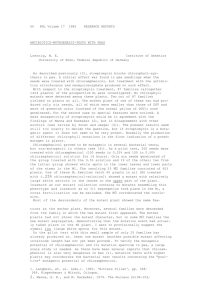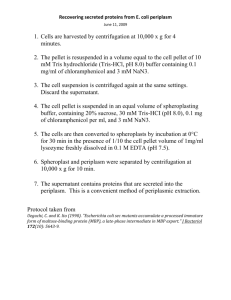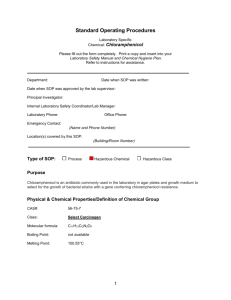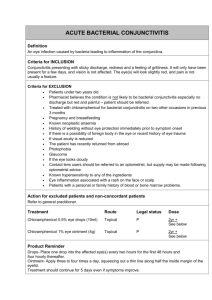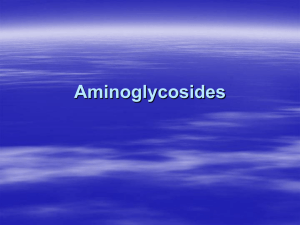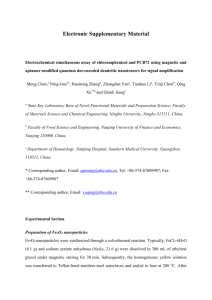Determination of Chloramphenicol from pure
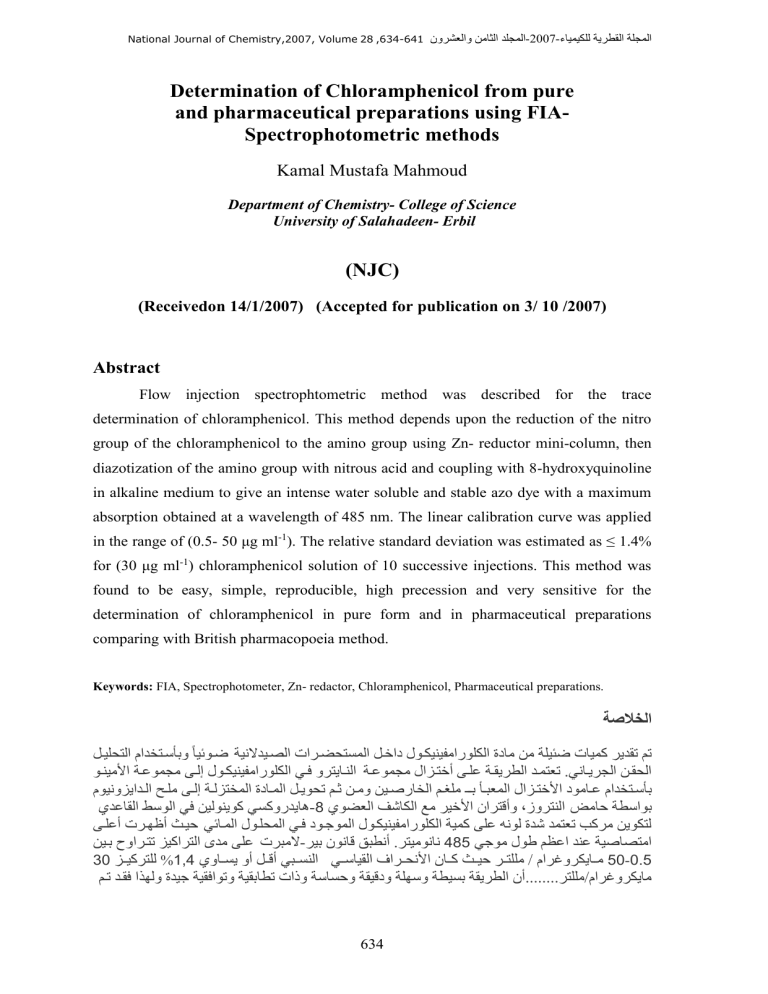
National Journal of Chemistry,2007, Volume 28 ,634-641 نورشعلاو نماثلا دلجملا 2007 ءايميكلل ةيرطقلا ةلجملا
Determination of Chloramphenicol from pure and pharmaceutical preparations using FIA-
Spectrophotometric methods
Kamal Mustafa Mahmoud
Department of Chemistry- College of Science
University of Salahadeen- Erbil
(NJC)
(Receivedon 14/1/2007) (Accepted for publication on 3/ 10 /2007)
Abstract
Flow injection spectrophtometric method was described for the trace determination of chloramphenicol. This method depends upon the reduction of the nitro group of the chloramphenicol to the amino group using Zn- reductor mini-column, then diazotization of the amino group with nitrous acid and coupling with 8-hydroxyquinoline in alkaline medium to give an intense water soluble and stable azo dye with a maximum absorption obtained at a wavelength of 485 nm. The linear calibration curve was applied in the range of (0.5- 50 μg ml -1 ). The relative standard deviation was estimated as ≤ 1.4% for (30 μg ml -1 ) chloramphenicol solution of 10 successive injections. This method was found to be easy, simple, reproducible, high precession and very sensitive for the determination of chloramphenicol in pure form and in pharmaceutical preparations comparing with British pharmacopoeia method.
Keywords: FIA, Spectrophotometer, Zn- redactor, Chloramphenicol, Pharmaceutical preparations.
ةصلاخلا
ويلضحلا ااداحوتسأو اييووض ةي ةديودلا تارورضحتملا وخا د ووكينيفمارولكلا ةدام نم ةليئض تايمك ريدقت مت
وونيم ا ةوأومجم زول ووكينيفمارولكلا وي ورحياونلا ةوأومجم اموحخل زولأ ةوقيرطلا دومحعت ت اويرجلا نوقضلا
اوي وميادوولا وولم زوول ةوولمحاملا ةداووملا وويوضت مووي نوومو نيوونراالا مووغلم ـ ووأ سوو عملا امووحخ ا دوماووأ ااداحووتس أ
يدأاقلا طتولا ي نيلونيوك تكوردياه
زولأل ترورهل ويح
نيوأ حو
ياوملا وولضملا وي دووووملا ووكينيفمارولكلا ةيمك زلأ ه ول ةدش دمحعت بكرم نيوكحل
اروحت ميكارحلا ىدم زلأ تر مة -
-
8
يورعلا فشاكلا عم ريخ ا نارحقلو ،زورحنل ا
ريأ نو اق ق ط ل ترحيمو ا
485
ضماح ةطتاوأ
ووم وط مظأا دنأ ةينادحما
30
موويكرحلل
% 1,4
يواووتي ول ووقل ووتنلا ووتايقلا ارووض ا ناووك وويح رووحللم م ااراوركياووم
موت دوقي اذرلو ةديو ةيقياوتو ةيقأاطت تاذو ةتاتحو ةقيقدو ةلرتو ةطيتأ ةقيرطلا نل
50 0.5
تتتتتتتت رحللممااراوركيام
634
National Journal of Chemistry,2007, Volume 28 ,634-641 نورشعلاو نماثلا دلجملا 2007 ءايميكلل ةيرطقلا ةلجملا
ةووقيرطلل ةويلمعلا ياوحنلا ميويقت موتو ة ي ةديوون تارورضحتم كوشأ دووووملا وووكينيفم اروولكلا ريدوقحل اورقي طت
اطير لا روحتدلا ق نم ةدمحعملا ةيتايقلا ةقيرطلا ياحنأ ةمداحتملا
Introduction
Chloramphenicol (CAP) is a potent inhibitor of bacterial protein synthesis, which was originally isolated from cultures of Streptomyces venezuelae
[1, 2]
.
Chloramphenicol remains the drug of choice for the treatment of salmonella infections such as typhoid and paratyphoid fever and in severe systemic
Arizona infections. Chloramphenicol is also used in various bacterial eye infections such as Bacillus cereus panophthalmitis , which occurs particularly in drug abusers, this is due to its high intraocular penetration properties.
Different methods were described for determination of chloramphenicol in both pure form and as pharmaceutical preparations. Simple photometric and colorimetric determinations chloramphenicol were investigated
[3-5]
. of
The viability of tandem photochemical reaction chemiluminescence’s detection was studied for a heterogeneous family of nitro compounds using chloramphenicol as a test substance [6] . Chloramphenicol has also been determined by electro generated chemiluminescence’s coupled to flow injection analysis (FIA) [7] .
* kamal_k58@yahoo.com
Recently it has been reported that the antibiotic chloramphenicol has been found in several imported foodstuffs from Asia, including shrimp, crab and crayfish. Several confirmatory analytical liquid chromatography methods with mass spectrometric detection and identification
[8] and liquid chromatography- atmospheric pressure photo-ionization mass spectrometry method were developed
[9]
for the determination of chloramphenicol in shrimps and fish meats respectively.
This work involved the on-line reduction of nitro group of chloramphenicol to amino group using
Zn- reductor mini-column, then diazotization of the reduced product with nitrous acid and coupling with 8hydroxyquinoline (oxine) in alkaline medium, producing an intense watersoluble azo dye with a maximum absorption obtained at a wavelength of
485 nm.
Experimental
Reagents:
All reagents were analytically pure unless stated otherwise and prepared in pure de-ionized water.
The pharmaceuticals tested were chloramphenicol (capsules), samaphenicol (capsules, eye drops) and otocaine (ear drops) from different drug industries. Stock solutions (500 µg ml -1
) of chloramphenicol with purity greater than 99% were prepared in ethanol stored in the dark at 4°C, and diluted to the desired concentrations prior to use.
The reductor was prepared according to the Jones reductor [10] .
Sodium nitrite (1.0 M): prepared by dissolving 17.25 g of NaNO
2
(Fluka) in 250 ml of water and stored in the dark at 4 o
C, other working solutions were prepared daily by appropriate dilutions with water.
HCl (1.0 M): 83.3 ml of 36% HCl
(BDH) was diluted to 1.0 l with water, other concentrations were prepared by serial dilution.
NaOH (2.0 M): 80 g of the reagent was dissolved in 1.0 l H
2
O and working solutions were prepared by appropriate dilution with water.
8- Hydroxyquinoline (1%): 1.0 g was dissolved in 100 ml ethanol.
635
National Journal of Chemistry,2007, Volume 28 ,634-641 نورشعلاو نماثلا دلجملا 2007 ءايميكلل ةيرطقلا ةلجملا
The chemical tested as foreign compounds in the interference study were soluble starch, KCl, NaCl,
MgCl
2
.6H
2
O, sucrose, lactose, glucose, phenol, tetracain and phenyl mercuric acetate (all from Fluka).
Apparatus:
The flow manifold consisted a
Rheodyne (5020) injection valve, USA-
Haake Buchler MCP 2500
Microprocessor peristaltic pump provided with a Teflon tubes with (0.8 mm i.d.). The flow cell was quartz with a
30 µl volume. The UV- Visible spectrophotometer determinations were accomplished with a model SP8- 300.
Fig.(1) shows the diagram of the flow injection manifold.
H
2
O
P
C
↓
HCl
NaNO
2
L1
L2
D
8-hydroxy quinoline
NaOH
W
Fig. (1): Flow injection diagram of system for chloamphenicol determination.
P: peristaltic pump, S: Sample , C: Reductor column , L1 & L2: reaction coils ,
D: Spectrophotometer detector , R: Recorder , W: Waste .
Results and Discussion
Preliminary studies:
First experiments were performed amalgam, 0.1 M HCl, 0.1 M NaNO
2
,
0.1% 8-hydroxyquinoline, 1.0M NaOH,
3.0 ml min
-1
flow rate, 20 and 100 cm by employing the flow manifold (Fig.
(1)) with injecting 100 µl of 500 µg ml -1 pure chloramphenicol as a sample and
Zn- amalgam packed in a mini-column
[10]
for reduction of the nitro group of the sample to amino group which diazotized with nitrous acid and coupled with 8hydroxyquinoline in basic medium, giving an orange color complex with coil lengths for L1 and L2 respectively.
Optimization of FI parameters:
Effect of reductor column length:
The lengths of reductor column were studied from (2- 10 cm) for reduction of 500 µg ml -1 of chloramphenicol. Table (1) shows the effect of the reductor column packed maximum absorption spectrum at a wavelength of 485 nm. The following parameters were selected and taken as bases of the following optimizations, with Zn- amalgam on the peak height
(mm), in which the optimum length was found to be 5 cm. Zn- amalgam was selected because it is the best reducing agent for chloramphenicol
[10, 11]
. reductor column (2 cm) packed with Zn-
Table (1): Effect of the reduction column length:
Length of reductor column (cm) Peak height (mm)
R
636
National Journal of Chemistry,2007, Volume 28 ,634-641 نورشعلاو نماثلا دلجملا 2007 ءايميكلل ةيرطقلا ةلجملا
2
3
4
5
6
7
8
9
10
58
65
74
77
75
70
67
60
55
85
80
75
70
65
60
Effect of flow- rate, delay coils and sample volume:
Optimizations of flow rate and delay coils were related to the diazotization of the reduced chloramphenicol and then coupling with 8-hydroxyquinoline. Therefore the manifold in Fig. (1) was operated.
A 500 µg ml -1 solution of chloramphenicol was selected as a typical example to maintain such physical optimizations. Fig. (2) illustrates the results of the combined flow rate which found that 4.0 ml min -1 is satisfactory, because below this flow
0 1 2 3 4
Flow Rate (ml/min)
5
Fig. (2): Effect of flow rate rate the time is not enough to form complex of the sample with the reagent while at higher flow rate the reduction process of the sample may not be happen completely.
The length of mixing coils was found to be 20 cm (L
1
) for mixing 0.1
M HCl with 0.1 M NaNO
2
to generate nitrous acids and 90 cm (L
2
) to achieve adequate reaction between sample and
HNO
2
. The sample volume was also optimized and 200 µl found to be the best. Teflon tubing (0.8 mm i.d.) was used for the rest of the manifold.
6 7 8
Optimization parameters: of chemical Different HCl concentrations were varied over the range 10
-3
- 1.0 M, its influence on the signals is presented
9
638
60
50
40
30
20
10
National Journal of Chemistry,2007, Volume 28 ,634-641 نورشعلاو نماثلا دلجملا 2007 ءايميكلل ةيرطقلا ةلجملا in Fig. (3) (Curve I) a sharp maximum was found at 5x10 being the concentration used in further work.
-2 M, which this
The NaNO
2
concentration was studied over the range 1.0
-3
- 1.0 M.
Fig. (3) (Curve II) illustrate that 0.1 M gave the best result, which was employed in all subsequent work.
Effect of different concentrations of 8-hydroxyquinoline (0.05- 0.4%) were investigated. Fig. (4) (Curve I) shows that 0.3% resulted in maximum outputs and was selected for further work. On mixing 8-hydroxyquinloine with diazotized chloramphenicol it was found that a color complex is produced only in the presence of strong alkaline medium, therefore different concentrations of NaOH were tested in the range (0.1- 2.0 M). The recorded outputs (Fig. (4) - Curve II) showed that 1.5 M was obtained as the optimum sensitivity.
90
80
HCl (I)
NaNO2 (II)
70
0
0.001
0.005
0.01
0.05
Concentration(M)
0.1
0.5
1
Fig.(3): Signal dependence of (I) HCl; (II) NaNO
2
concentrations on the peak height.
2
National Journal of Chemistry,2007, Volume 28 ,634-641 نورشعلاو نماثلا دلجملا 2007 ءايميكلل ةيرطقلا ةلجملا
0.1
0.5
Concentration(M)
1 1.5
2
100
90
80
70
60
50
40
30
8-Hydroxy (I)
NaOH (II)
120
100
80
60
40
20
10
20
0 0
0.05
0.1
0.2
0.3
0.4
Conentration(M)
Concentration (%)
Fig.(4): Signal dependence on (I) 8-hydroxyquinoline; (II) NaOH concentrations on the peak height.
Analytical applications:
After all the parameters were optimized, the calibration curve obtained by using fresh solutions of pure chloramphenicol standards within the range from 0.1- 500 µg ml
-1
. The chloramphenicol until this relationship was reached. The relative standard deviation was estimated as ≤ 1.4% for
30µg ml -1 chloramphenicol aqueous solution (n= 10) and the sample throughout was 70h
-1
. obtained analytical calibration curve is described by the equation:
Y = - 1.05x10
-2
+ 0.0752 log X
Where, Y is the peak height in
(mm) and X is the chloramphenicol concentration in µg ml
-1
. The response was linear over the range 0.5- 50 µg ml
-1
chloramphenicol. The correlation coefficient was estimated as 0.9967.
The limit of detection, defined as the average blank peak height plus 3x
RSD, was 10 -2 µg ml -1 of chloramphenicol and was determined experimentally by decreasing the concentration of injected
The response of the chloramphenicol in samples containing other additives such as in pharmaceutical preparations were compared with the response of a solution containing only the pure analyte for a concentration of 10 µg ml
-1
chloramphenicol, to show the selectivity of the method. Results are shown in Table (2). However, some cationic and anionic interference can be eliminated easily by introduction of a suppressor mini-column into the FIA system
[12]
.
639
National Journal of Chemistry,2007, Volume 28 ,634-641 نورشعلاو نماثلا دلجملا 2007 ءايميكلل ةيرطقلا ةلجملا
Commercial samples of pharmaceuticals (capsules, eye drops and ear drops) were analyzed by the proposed method and results were compared with the standard methods in
British pharmacopoeia
[2]
. The results are shown in Table (3), and good agreements were found.
Table (2): Effect of foreign compounds on the determination of 10µg ml -1 chloramphenicol:
Interference% Interfering
Compounds
NaCl
KCl
MgCl
2
Starch
Glucose
Sucrose
Lactose
Phenol
Tetracaine
Phenyl mercuric acetate
Molar ratio
Chloramphenicol/
Interfering
1:100
1:100
1:100
2:10
1:50
1:50
1:50
1:50
1:20
1:5
+1.00
-2.01
-1.50
+1.80
-2.22
-3.00
+2.03
+2.18
+1.89
+1.00
Table (3): Determination of chloramphenicol in pharmaceutical preparations:
Amount found
Drugs Contents
250
(mg/capsule)
250
(mg/capsule)
0.5%
Proposed method
248
(mg/capsule)
251
Recover y%
British
Pharmacopiea [
2]
247.0 Chloramphenicol
(Capsule) *
Samaphenicol
(Capsule)
*
Samaphenicol
(eye drop)
*
0.51%
99.2
100.4
102
251.5
0.52%
Otocaine
(ear drop)
*
1.2%
* Supplier: Massoud-Bahri & Co. “MBC” Damascus- Syria
1.24%
Recovery
%
98.8
100.6
104.0
103.3
Conclusions:
A flow injection spectrophtometric method can be successfully employed for the determination of chloramphenicol in pure form and pharmaceutical preparations with advantages in time of analysis, simplicity, cost, accuracy, precession and sensitivity. The proposed method requires neither temperature control nor solvent extraction step, and can successfully be applied without prelimining treatment.
The regeneration of the reductor is simple and not required more than once a week.
640
National Journal of Chemistry,2007, Volume 28 ,634-641 نورشعلاو نماثلا دلجملا 2007 ءايميكلل ةيرطقلا ةلجملا
References:
1The US Pharmacopoeia XXIII
,1995, the National Formulary:
MD, USA.
2British Pharmacopoeia ,1993, Her
Majesties Stationary Office:
London.
3-
Tiraspol’skaya SG Stepanyuk SN and Filip’era KN , Photometric determination of levomycetin in drug forms, Farmatsiya, 1980,
29(6) , 48.
4Nangia HE , Colorimetric determination of chloramphenicol,
Pharm.,1981, 24 (286) , 125.
5Shihab YM , Development of new photometric methods to estimate manufactured chloramphenicol from SFDI (Samara Factory of
Drug Industries), M. Sc. Thesis ,
University of Mosul- Iraq, 1990,
28.
6David V M Saez RM Garcia JV and Calatayud M,Enhanced chemiluminescent determination of chloramphenicol and related nitro compounds by on-line photochemical reaction, Analyst ,
2000, 125 , 1313.
7Lindino CA and Bulhoes LOS ,
Determination of chloramphenicol in tablets by electro generated chemiluminescence’s, J. Braz.
Chem. Soc ., 2004, 15(0,1-x)1.
641
8Ramos M Mum~oz P Aranda A
Rodriguez I Diaz R and Blanca J ,
Determination of chloramphenicol residues in shrimps by liquid chromatography- mass spectroscopy, J. Chromatography ,
2003, 791(1-2) , 31.
9Takino M Daishima S and
Nakahara T, Determination of chloramphenicol residues in fish meats by liquid chromatography- atmospheric pressure photo ionization mass spectrometry,.
J.
Chromatography , 2003 , 1011(1-
2) , 67.
10 Faizullah AT and Townshend,
Anal. Chem. Acta, 1985, 167 , 225.
11 Hassan SM Belal F Sharef El-Din
M and Sultan M, Analy. J., 1988,
133 , 1087.
12Faizullah AT and Ali DS,
Combination of flow injection chemiluminescence’s technique with ion exchanger, JDU Journal of Dohuk University .; 1999, 2(2) ,
131.

